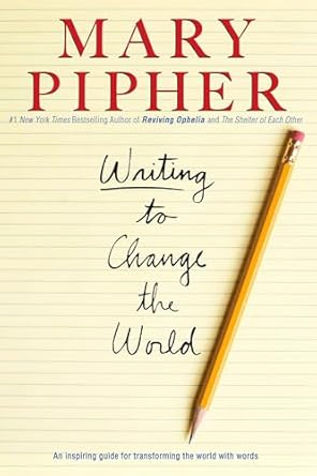

Rex Allen Holiday, LLC
Rex A. Holiday, Ph.D.
E-Learning Development
Curriculum Development
Higher Education Instruction
AI Prompt Engineering
Technical Content Writing
.jpeg)

Mary Pipher’s Writing to Change the World is more than a guidebook—it is a heartfelt invitation to use words with purpose. From the very first pages, Pipher urges writers to recognize the weight and influence of language, reminding us that writing is not simply self-expression but an act of connection, persuasion, and, ultimately, transformation.
What stands out most to me is Pipher’s insistence that effective writing must be both intentional and honest. She doesn’t present writing as a mechanical process of producing polished sentences; rather, she frames it as a deeply human endeavor that requires sincerity. Readers are encouraged to speak from their truest selves and to remain clear about why they are writing in the first place. This sense of clarity and authenticity, she suggests, is what allows words to move beyond the page and stir readers to reflection, empathy, or even action.
Pipher also weaves together practical advice with inspiring examples, showing how writers throughout history have used honesty and intentionality to challenge norms, advocate for justice, and build bridges across differences. Her approach is both motivating and grounding—she reminds us that while we may not change the entire world with one piece of writing, we can touch lives and contribute to meaningful conversations when we write with courage and integrity.
For me, the book is a call to pause before writing and ask: What truth am I trying to share, and why does it matter? By keeping these questions at the center, I find myself writing with greater focus, compassion, and honesty.
In short, Writing to Change the World is a powerful companion for anyone who believes that words, when used with intention and sincerity, can make a difference. It does not offer shortcuts or formulas, but instead reminds us that the most transformative writing springs from honesty and a deliberate desire to contribute something meaningful.
Work Cited
Pipher, Mary. Writing to Change the World. Riverhead Books, 2007.

Danny Iny’s Leveraged Learning is both a critique of traditional education systems and a forward-looking vision of how learning is evolving in an age of constant change. At its heart, the book emphasizes that learning is not optional—it is essential. Iny argues persuasively that the ability to continually acquire knowledge and skills is a critical factor in the success of individuals and organizations alike.
One of the book’s central insights is that education is no longer confined to the classroom or limited to a specific period of life. Instead, lifelong learning has become the new standard. For individuals, this means that personal growth, adaptability, and professional relevance depend on maintaining a habit of ongoing education. Iny points out that in a rapidly changing world, those who stop learning risk becoming stagnant, while those who embrace continuous learning stay ahead.
On an organizational level, Iny highlights how companies that cultivate learning cultures gain a competitive edge. He shows that businesses thrive when they encourage curiosity, provide opportunities for skill development, and invest in the intellectual growth of their people. In this sense, learning is not just a personal endeavor but also a strategic asset that can drive innovation, collaboration, and long-term sustainability.
What makes Iny’s approach especially compelling is the balance between practical advice and visionary thinking. He not only addresses how individuals can take ownership of their learning journeys, but also explains how leaders and educators can structure environments that empower learners to succeed. In doing so, he reframes education as a dynamic, interactive process rather than a passive transfer of information.
Ultimately, Leveraged Learning serves as a call to action: if individuals want to flourish and organizations want to prosper, both must commit to learning as a continuous, intentional pursuit. Iny makes clear that learning is not just about keeping pace with change—it is the foundation for shaping the future.
Works Cited
Iny, Danny. Leveraged Learning: How the Disruption of Education Helps Lifelong Learners, and Experts with Something to Teach. Mirasee, 2018.

How Learning Works is a deeply practical and research-driven guide that bridges the gap between learning theory and classroom practice. Susan A. Ambrose and her coauthors present seven core principles of learning, but what makes the book especially valuable is how these principles can be applied to real teaching and learning contexts. Rather than focusing on abstract concepts, the authors emphasize strategies that encourage students to actively engage with material, apply their knowledge, and learn through experience.
The strength of this book lies in its commitment to applied learning. The authors remind us that true understanding is not gained through passive memorization but through opportunities to use and test knowledge in meaningful ways. By integrating research from cognitive psychology, educational theory, and classroom studies, the book demonstrates how learners retain and transfer knowledge when they are given the chance to practice, reflect, and connect learning to real-world contexts.
Experiential learning emerges as a powerful thread throughout the text. Ambrose and her colleagues show that when learners are immersed in hands-on activities, case studies, problem-solving, and reflective exercises, they not only build competence but also develop confidence in applying what they know. For teachers, the message is clear: creating experiences where learners do something with knowledge is essential to lasting learning.
Ultimately, How Learning Works is both a guide and a challenge to educators. It challenges us to move beyond lecture-based models and to design learning experiences that are interactive, applied, and student-centered. By focusing on experiential strategies, the book equips educators to foster deeper understanding and to prepare learners for success in academic, professional, and personal contexts.
Works Cited
Ambrose, Susan A., et al. How Learning Works: Seven Research-Based Principles for Smart Teaching. Jossey-Bass, 2010.